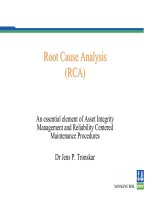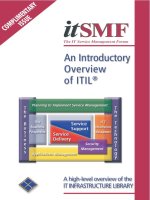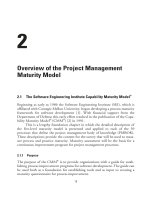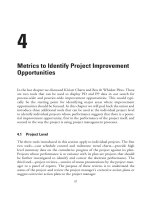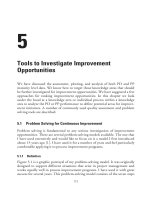FDIC presentation on Asset Liability Management Process 4-11
Bạn đang xem bản rút gọn của tài liệu. Xem và tải ngay bản đầy đủ của tài liệu tại đây (440.88 KB, 33 trang )
The ALCO Process:
A View From the Regulatory Arena
1
Discussion Points
• Outline the responsibilities of an asset liability
committee (ALCO).
• Discuss commonly observed ALCO best practices
in community banks.
• Review areas of the ALCO policy and/or ALCO
activities that could be enhanced.
• Discuss liquidity risk management.
• Review new IRR guidance.
• Discuss regulatory ALM modeling tips.
• Introduce upcoming guidance on credit risk
analysis of investment securities.
2
Asset-Liability Committee (ALCO)
Responsibilities
ALCO Composition
• Senior management committee in a financial institution responsible for coordinating the
institution's borrowing and lending strategy, and funds acquisition to meet profitability
objectives as interest rates change.
ALCO Responsibilities – Liquidity Risk Exposure
• The ALCO should actively monitor the institution’s liquidity profile and should have
sufficiently broad representation across major institutional functions that can directly
influence the institution’s liquidity risk profile (e.g., lending, investment securities,
wholesale and retail funding).
• For example, the ALCO will have responsibility for setting limits on the arbitrage of
short-term borrowing, while lending long-term instruments. Among the factors
considered are liquidity risk, interest rate risk, operational risk and external events that
may affect the bank's forecast and strategic balance-sheet allocations.
ALCO Responsibilities – Interest Rate Risk Exposure
• The ALCO should ensure that the risk measurement system adequately identifies and
quantifies risk exposure.
Reporting
• The ALCO will generally report to the board of directors and will also have regulatory
reporting responsibilities. Reporting process should communicate accurate, timely, and
relevant information about the level and sources of risk exposure.
3
Asset-Liability Management
• Typically, asset-liability management
(ALM) is associated with reporting a
financial institution’s historical Gap, EVE,
and net interest income sensitivity results.
• Ideally, ALM should involve an integrated
process between interest rate risk,
liquidity risk management, budgeting, and
strategic planning that includes the entire
bank; and develops future dynamic
strategies that balance risk and
profitability.
4
ALCO Best Practices
Observed in Community Banks
•
Although there is no official written guidance that outlines regulatory
expectations of the ALCO, the following are ALCO best practices observed
by examiners of community banks:
o Liquidity that is readily available, including the availability of collateral to be
pledged.
o Credit lines accessible with material adverse change clauses readily
accessible to determine circumstances that would disallow use of the lines.
o Limitations on particular types of deposits that can be accumulated, for
example, municipal deposits.
o ALCO package that includes a 1-page summary covering all key model
assumptions including any recent changes to the assumptions.
o Funding diversification guidelines.
o Establishing targets and composition mix of the investment portfolio.
o IRR and liquidity limits that require action vs. additional discussion (e.g.,
Red, Yellow, Green).
o ALCO packages that show level and trends vs. just showing the level
specifically for risk limits.
o Cash flow coverage for runoff of collateralized deposits.
o Testing credit lines at least annually.
5
ALCO Best Practices
Observed in Community Banks (con’d)
• Although there is no official written guidance that outlines
regulatory expectations of the ALCO policy, the following are
ALCO policy best practices observed by examiners of
community banks:
o Has substance, structure and focus.
o Ties-in other policy parameters, e.g., Investment Policy
guidelines and the impact on liquidity.
o Includes description of how key assumptions are
determined, and the source documents used to make the
assumptions.
o Includes minimum risk limits for maintaining liquid,
unencumbered assets.
o Includes a definition of liquidity assets.
o Outlines expectations for independent review.
o Includes funding risk limits by maturity, e.g., limits on shortterm, wholesale funding).
6
What can a well-run ALCO do even better?
• Provide clearer and more descriptive language in
the ALCO minutes in regards to ALCO meetings.
For example -o Who contributes to the discussion?
o What is actually said?
• Provide details on the status, risks, and results of
previously implemented strategies.
• Conduct sensitivity testing of key assumptions.
• Further develop contingency planning.
• Back-testing.
7
Common Examination Criticisms of the
ALCO Function and/or ALCO Policy
•
•
•
•
•
•
•
•
•
•
•
Lack of detail on type of collateral available for pledging purposes.
Ability to track borrowing capacity and availability of funding from various
sources.
Lack of policy limits for liquidity, or lack of meaningful policy limits.
Inability of management to explain why certain limits were established.
Base-case and stress scenarios are not adequately explained relative to the
bank’s overall condition.
Inadequate modeling of new products and/or new strategies prior to
implementation.
ALCO report package does not adequately explain the bank’s current balance
sheet risk-return profile.
Not considering current level of earnings and capital when assessing risk limits,
e.g., a risk limit of 15% of net interest income could eliminate earnings.
Not revisiting established risk limits periodically to determine continued
relevance.
Lack of documentation for key assumptions, e.g., deposit betas, prepayments.
No sensitivity testing of key assumptions.
8
Liquidity Risk Management:
Points of Emphasis
• Corporate Governance
• Risk Tolerances
• Liquidity Risk Measurement, Monitoring,
and Reporting
• Stress Testing
• Collateral Position Monitoring
• Funding Diversification
• Contingency Funding Plans
• Liquid Asset Cushion
9
Corporate Governance
•
•
•
•
Understanding nature of risk
Periodic reviews
Lines of authority and responsibility
Development and implementation of
appropriate policies and risk measurement
and monitoring systems
10
Risk Tolerances
• Unencumbered liquid asset reserves
• Identification of unstable and liquid asset
coverage ratios
• Cash flow projections
• Funding concentrations
11
Liquidity Risk Measurement, Monitoring,
and Reporting
• Cash flow projections
• Reasonable, appropriate, and welldocumented assumptions
• Meaningful time horizons
12
Stress Testing
•
•
•
•
•
Institution specific scenarios
Market wide events
Multiple time horizons
Sources of potential liquidity strain
Impact on cash flows, liquidity position,
profitability, and solvency
13
Collateral Position Management
• Value of pledged assets relative to amount
of security required
• Unencumbered assets available to be
pledged
14
Funding Diversification
• Effective diversification in the types and
tenor of sources
• Maintenance of market access
• Identification of alternative funding
sources in a variety of scenarios
15
Contingency Funding Plans
•
•
•
•
•
Identify Stress Events
Assess Levels of Severity and Timing
Assess Funding Sources and Needs
Identify Potential Funding Sources
Establish Liquidity Even Management
Processes
• Establish a Monitoring Framework for
Contingent Events
16
Contingency Funding Triggers
•
•
•
•
•
•
•
Reputation Event
Asset Quality Event
Funding Event
Economic Event
Capital Event
Regulator Event
Liquidity Ratio Violation
17
Liquid Asset Cushion
• Availability of a cushion of liquid assets
without legal, regulatory, or operational
impediments
• Availability to be sold or pledged to obtain
funds in a range of stress scenarios
• Inclusion of contractual and
noncontractual cash flows
18
Advisory on Interest Rate Risk
Management (January 6, 2010)
19
Interest Rate Risk Guidance
• FIL-52-96: Joint Interagency Policy
Statement on Interest Rate Risk
• FIL-2-2010: Financial Institution
Management of Interest Rate Risk
20
Why did we issue the advisory?
• Address the importance of having robust
processes for measuring and mitigating, as
necessary, exposures to potential increases in
interest rates.
• Emphasize the importance of effective corporate
governance, policies and procedures, risk
measuring and monitoring systems, stress
testing, and internal controls.
21
IRR Guidance:
Major Areas of Concern
• Corporate Governance
Understanding risk profile.
Establishment, approval, and implementation of IRR
management strategies, policies, procedures and risk
tolerances.
Integration of new strategies, products, and business
into IRR system.
Firm-wide risk management efforts.
• Measurement and Monitoring of IRR
Fully understand underlying analytics, assumptions,
and methodologies.
Selection of appropriate time horizons.
22
IRR Guidance:
Major Areas of Concern
• Stress Testing
Instantaneous and significant changes in interest rate
levels (e.g., up and down 300 and 400 basis points)
across different tenors to reflect changing slopes and
twists of the yield curve.
Prolonged rate shocks.
Changes in relationships in key rates and slope of yield
curve.
• Assumptions
Reasonableness of prepayments, NMD sensitivities and
decay rates, and key rate drivers.
Historical and forward analysis.
23
IRR Guidance:
Major Areas of Concern
• Risk Mitigating Steps
Identification of IRR exposures
Discussions of risk and appropriate action steps given
the scenario
• Internal Controls and Validation – Model
Validation
Independent review of the logical and conceptual
soundness
Reasonableness of assumptions
Backtesting of assumptions
Adequate follow-up procedures
24
General Theme
All measurement involves error. As a result,
there is a need to:
• Sensitivity Test – How wrong on average?
• Stress Test – How bad can it get?
• Back Test – How accurate were my forecasts?
25

